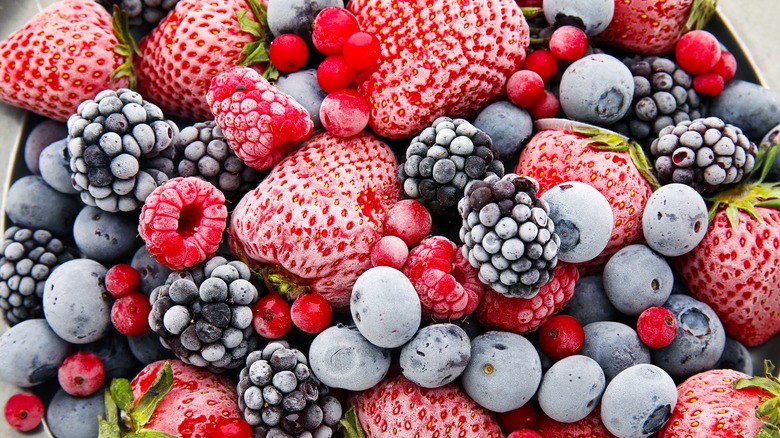The Fresh Secret Behind Frozen Foods
Thanks to frozen food, we can eat out-of-season foods year-round. Strawberries can be enjoyed in the peak of winter if you so desire. If you need a quick meal to end a busy day, you can simply reach into the freezer for a pizza or frozen meal. This incredibly convenient invention hasn't been around so long — only about 100 years in a form you'd recognize today — but it's crucial for keeping fresh foods for a few months rather than a few days. It's easy to assume that a frozen fruit or veggie isn't as nutritious or tasty as fresh, but this isn't necessarily true.
When it comes to commercially frozen foods, producers try to get freshly picked produce processed and frozen as quickly as possible. The reason behind the speed is to preserve the flavor, texture, and nutritional value; as soon as food is harvested, it starts to deteriorate. Surprisingly, food that gets commercially frozen is often processed quicker than the fresh food we purchase at the grocery store. It may only take two hours for something like berries or peas to be harvested, processed, and frozen, while it could take days for the same fresh foods to reach grocery store shelves. Technically speaking, frozen foods may be more "farm fresh" and contain more nutrients than fresh produce, as it was preserved more quickly right after harvest in a state of peak ripeness.
How commercial freezing works
The actual freezing process is rapid for commercially frozen foods. Our in-home freezers are small boxes that take several hours to freeze fresh food, but the commercial freezing process can occur in a matter of minutes. This is beneficial because slower freezing time results in the development of larger crystals; once defrosted, this would result in mushier, liquid foods. The smaller the ice crystals, the better — and this can be achieved by getting food into a frozen state faster.
In commercial freezing operations, there are several ways that food gets frozen faster. Rather than sticking in a freezer box, one method sends the food through a tunnel where food is blasted with air at around -40 degrees Fahrenheit– this method is most commonly used for fresh produce, packaged foods, poultry, and baked goods. Another method is using blast freezing for foods, like meat and poultry, as they move through a conveyor belt with air set at a similar temperature.
Managing frozen foods at home
Commercial freezers are different than our at-home freezers, but there are a few tips and tricks on how to freeze things to maximize their freshness and lifespan. Sure, frozen food can be tossed in the freezer and forgotten about, but some preparation prevents freezer burn and off-putting tastes and textures. For starters, consider blanching vegetables before storing them in the freezer. Blanching involves placing vegetables in boiling water for several minutes and then quickly cooling them in ice-cold water — this process diminishes enzymes that contribute to the degradation of vegetables.
If you open a package, of say, frozen waffles or berries, be sure to reseal correctly. Squeeze the air out and use a clip if needed to close the bag completely. For packages with large openings or rips and tears, transfer to an airtight container or plastic bag. Freezer burn occurs when frozen foods are exposed to the air in your freezer; and although this doesn't mean the food is bad, it does affect the quality of taste and texture.
When you cook something like frozen vegetables or french fries, how you cook them matters. Frozen fries should be popped in a hot oven immediately, at a lower temperature than what the package recommends. The same goes for veggies — frozen vegetables should not be thawed, and placed in a hot oven straight from the freezer. Once mostly cooked, add oil and seasonings, and cook for another 10 minutes for the crispiest vegetables.


